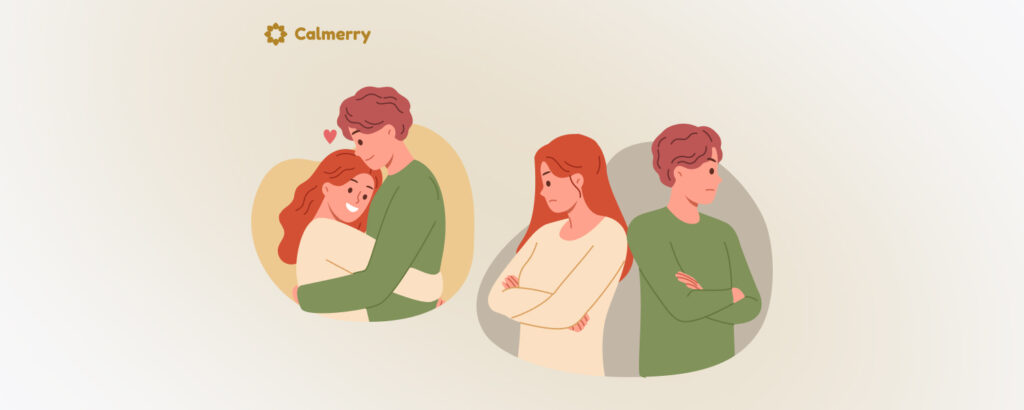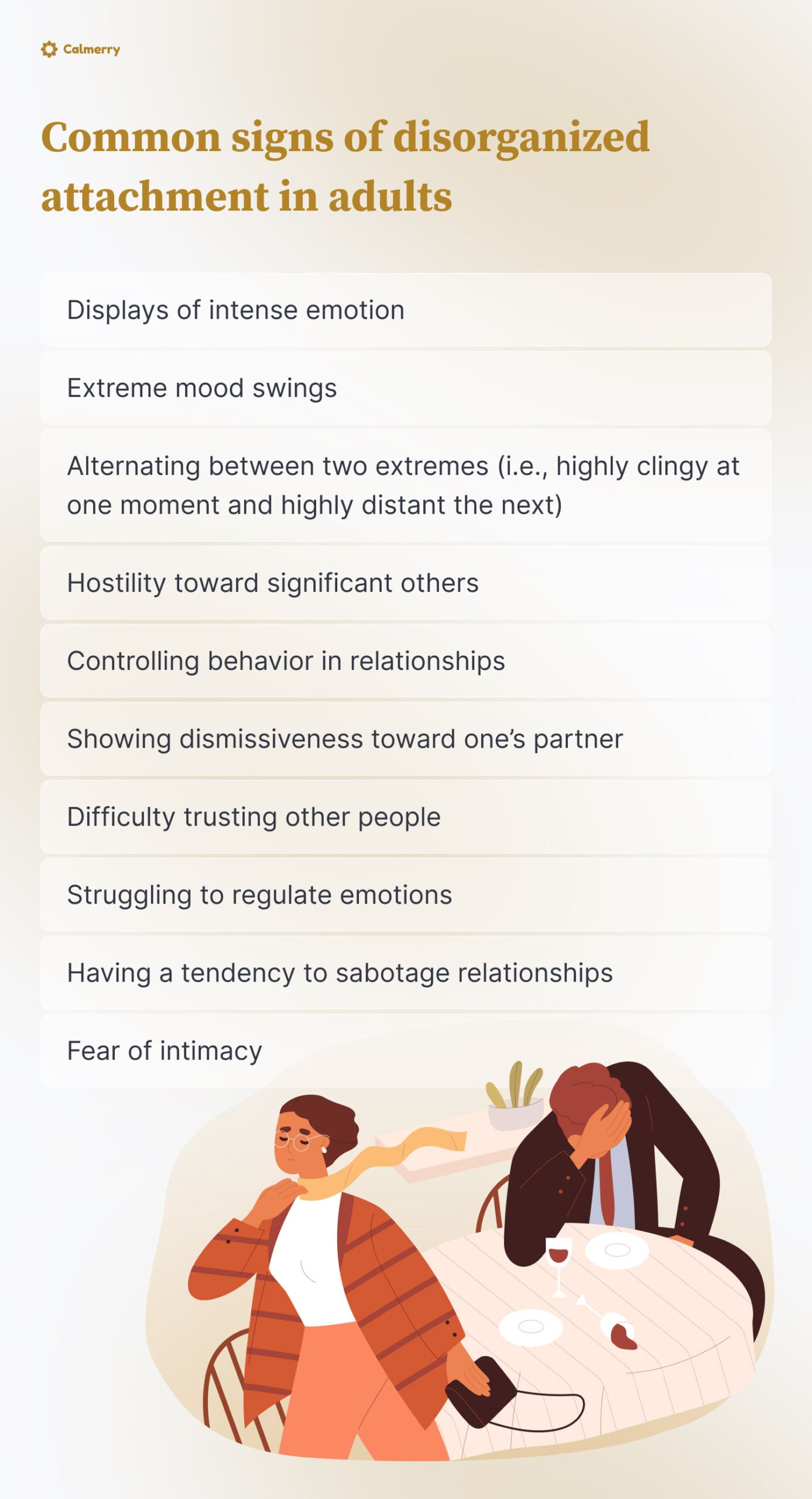Disorganized Attachment Style: Signs, Causes, and Management

In this article
If you’ve researched relationship issues, you’ve probably heard of attachment styles. An attachment style refers to our expectations of others in close relationships.
For instance, our attachment style determines how we expect people to treat us when we’re upset or distressed, and whether we’re comfortable connecting with others.
Attachment styles are largely based on our early experiences with our caregivers. If we learn we can rely on caregivers to meet our needs and calm us during distress, we develop a secure attachment style.
Those of us with secure attachment styles are comfortable forming close bonds with others and relying on people to meet our needs.
On the other hand, if we cannot rely on caretakers because they are absent or abusive, we can develop insecure attachment styles, which can negatively affect our adult relationships.
There are various different attachment styles that fall under the category of an insecure attachment. One type of insecure attachment is the disorganized attachment style.
We’ll cover all the details of this attachment style, including signs, symptoms, and ways to cope, below.
What is a disorganized attachment style?
The disorganized attachment style is one type of insecure attachment. [1] Paetzold, R., & Rholes, W. S. (2020). Disorganized attachment style. In Springer eBooks (pp. 1155–1162). https://doi.org/10.1007/978-3-319-24612-3_2021 Unlike anxious or avoidant attachments, which are also forms of insecure attachment, the disorganized attachment style has no clear pattern.
Individuals with an avoidant attachment style do not seek comfort from partners in times of distress. They appear emotionally distant and aren’t comfortable with intimacy.
On the other hand, anxiously attached individuals are not sure that they can trust significant others. They are hesitant to explore interests outside the relationship, and they aren’t easily comforted by their partner when distressed.
While both avoidant and anxious attachment styles have a predictable pattern, the disorganized attachment style does not. This is why it goes by the title “disorganized.”
People with disorganized attachment style show neither a consistent pattern of avoidance nor anxiety related to attachment. Instead, their attachment behaviors can appear odd, characterized by fear, conflict, apprehension, and disorientation.

What are the signs and symptoms of disorganized attachment?
The disorganized attachment style comes with some key indicators. [2] Beeney, J. E., Wright, A. G. C., Stepp, S. D., Hallquist, M. N., Lazarus, S. A., Beeney, J. R. S., Scott, L. N., & Pilkonis, P. A. (2017). Disorganized attachment and personality functioning in adults: A latent class analysis. Personality Disorders, 8(3), 206–216. https://doi.org/10.1037/per0000184
Below are some common signs and symptoms of disorganized attachment in adults:
- Displays of intense emotion
- Extreme mood swings
- Alternating between two extremes (i.e., highly clingy at one moment and highly distant the next)
- Hostility toward significant others
- Controlling behavior in relationships
- Showing dismissiveness toward one’s partner
- Difficulty trusting other people
- Struggling to regulate emotions
- Having a tendency to sabotage relationships
- Fear of intimacy
People with disorganized attachment styles show these symptoms because they are quite conflicted.
On the one hand, they deserve to develop close, meaningful relationships. On the other hand, they do not feel safe being emotionally close to others.
This can result in a pattern of chaotic relationships, in which things seem to be fine one moment, but highly conflictual the next.
Because of this pattern, a person with a disorganized attachment style appears quite dysregulated within the context of their relationships.
Causes and risk factors
When people have pleasant experiences with their early caregivers, they develop secure attachments. A secure attachment is based on a solid foundation in which early childhood caretakers were nurturing, warm, and available.
When a child does not have this type of caretaker, they are vulnerable to attachment problems. So, the disorganized attachment style can develop in response to the following risk factors.
History of trauma
A history of trauma, especially during childhood, is one of the primary causes of a disorganized attachment style. [3] Jacobvitz, D., & Reisz, S. (2019). Disorganized and unresolved states in adulthood. Current Opinion in Psychology, 25, 172–176. https://doi.org/10.1016/j.copsyc.2018.06.006
Unresolved fear from trauma can cause fear in romantic relationships, thereby leading to disorganized attachment symptoms.
When parents or other close caretakers are the perpetrators of some form of abuse that results in trauma, the child comes to fear their caretakers. This creates a contradictory experience, in which the people the child should rely on for protection are sources of fear and anxiety.
This unresolved trauma can affect a person into adulthood, resulting in disorganized attachment behavior. While caretakers were once a source of fear, now, in adulthood, romantic partners can induce fear.
Unresolved trauma in a caretaker
A person need not experience trauma themselves to develop a disorganized attachment style. They can also become disorganized if one of their primary caretakers struggles with unresolved trauma.
For instance, mothers who have a history of trauma may appear dazed or frozen, which can be frightening to their infants. Over time, this causes a disorganized attachment style, because the caretaker is simultaneously frightening, but also responsible for providing comfort.
Genetics
Finally, there is some evidence that genetic differences can impact the development of attachment styles. [4] Antonucci, L. A., Taurisano, P., Coppola, G., & Cassibba, R. (2018). Attachment style: The neurobiological substrate, interaction with genetics and role in neurodevelopmental disorders risk pathways. Neuroscience & Biobehavioral Reviews/Neuroscience and Biobehavioral Reviews, 95, 515–527. https://doi.org/10.1016/j.neubiorev.2018.11.002 For example, some gene variations can affect the way that early experiences with caretakers influence attachment.
So, some people may be more genetically vulnerable to developing attachment problems in response to maltreatment or neglect from caretakers.
How do people with disorganized attachment act in relationships?
Someone with a disorganized attachment style may have a difficult time maintaining healthy relationships. They tend to strongly desire close relationships, but they don’t feel safe engaging in them.
So, what happens is, they enter relationships and show hot and cold behavior. They may start to grow close to a partner, only to pull away once the relationship starts to become more serious.
A person with a disorganized attachment style is also likely to struggle to trust a significant other. After all, they couldn’t trust their own caretakers, so why would they trust a partner as an adult?
For a person with a disorganized attachment style, lack of trust can lead to constant fear that a significant other will abandon or betray them. This can cause behaviors such as frequently questioning a significant other’s whereabouts, or accusing them of infidelity with no evidence.
Finally, emotions tend to run strong for those with disorganized attachment styles. Routine conflict and daily stressors within the relationship can cause intense mood swings and outbursts of anger, fear, or sadness.
Can someone with a disorganized attachment have a healthy relationship?
The behaviors that come along with a disorganized attachment style can make it difficult to have healthy relationships. But this doesn’t mean that it’s impossible to enjoy a meaningful relationship with this attachment style.
Once you become aware that you have a disorganized attachment style, you can make an effort to change unhelpful behaviors and thinking patterns.
With time and effort, you can overcome unhelpful ways of viewing others and learn to have a healthy, enjoyable relationship with a significant other.
The first step is acknowledging that there is a problem.
Strategies for managing disorganized attachment
If you’re aware that you have a disorganized attachment style, there are several strategies you can use to manage unhelpful thoughts and behaviors related to this attachment style.
Consider the strategies below. Some of these self-help strategies can be implemented at home, whereas others may require formal intervention.
1. Learn to identify your triggers
When someone has a disorganized attachment style, certain triggers usually activate attachment fears. For instance, conflict with a partner, significant stress, or time spent away from a partner can all be triggers.
Once you identify your triggers, it can be easier to manage them. You can share your triggers with your significant other, so they can be mindful of them as well.
It may not be possible to avoid triggers altogether, but when you know you’ll be exposed to a trigger, you can take extra steps to care for yourself.
2. Learn healthy coping strategies
A disorganized attachment style often comes with intense emotions. When you’re faced with conflict or upsetting feelings in your relationship, you’re likely to have a difficult time regulating these emotions.
Rather than letting your emotions get the best of you, try to learn some healthy coping strategies. This might include going outside for a walk, practicing deep breathing, or taking a moment for prayer or meditation when you’re overwhelmed by intense emotions.
3. Consider alternative explanations
When attachment wounds are triggered, you’re likely to feel fear and uncertainty. This can lead to a thought process called catastrophizing, in which you imagine the worst possible scenario and assume it’s true.
In a relationship, this can look like assuming your partner is about to leave you, or deciding that they’re for certain cheating on you.
Rather than allowing your thoughts to go to the worst possible scenario, consider alternative explanations.
What if your significant other is just busy or having a bad day? Pause before jumping to conclusions, and you’ll likely find that your fears subside a bit.
4. Attend a support group
It can also be helpful to attend a support group designed for people who have trouble with relationships. These support groups may be offered in person at a local community mental health center. Or, you can find online support groups.
The point of these groups is that they link you to others who are experiencing similar challenges. In these settings, you can learn from people who are also going through what you’re experiencing.
5. Seek therapy
As we’ve discussed above, a disorganized attachment style is often the result of unhealed trauma or problems in relationships with caretakers during early childhood.
This means you may need professional support to help you overcome attachment problems. In therapy sessions, you can address whatever unresolved wounds are contributing to current attachment problems in your relationships.
How therapy can help individuals with disorganized attachment
If you have a disorganized attachment style, therapy can be incredibly helpful.
First, a therapist can provide professional treatment for any underlying mental health condition related to your attachment problems, such as PTSD or a personality disorder.
Next, a therapist can help you learn healthy coping skills and develop strategies for managing uncomfortable emotions. While you can practice some of these strategies on your own, sometimes, people require professional support to help them learn to cope in a healthier way.
In many cases, people are unaware of the underlying problems contributing to issues like a disorganized attachment style. A therapist can help you identify the root of the problem, so you can begin to heal.
Finally, therapists can provide you with tools to help you challenge your thinking patterns. For instance, if you are stuck on the belief that your significant other cannot be trusted, your therapist can help you explore thinking errors contributing to this belief.
What is the best therapy for disorganized attachment?
Therapy is not one-size-fits-all, and the best type of therapy will depend upon your unique needs, preferences, and situation.
That being said, certain modalities may be particularly effective for people struggling with a disorganized attachment style:
- For example, psychodynamic therapy is often used to treat people struggling with an insecure attachment style. [5] Karnac Books. (n.d.). Psychotherapy with People who have Disorganised Attachment Patter. . .: Ingenta Connect. https://www.ingentaconnect.com/content/phoenix This modality explores how unresolved childhood issues affect a person in the present. It can also help people identify unconscious drives and motives affecting their behavior.
- Trauma-focused cognitive behavioral therapy can also be helpful for addressing attachment issues, given the link between trauma and disorganized attachment. [6] Pleines, K. E. (2019). An Attachment-Informed approach to Trauma-Focused Cognitive Behavioral therapy. Clinical Social Work Journal, 47(4), 343–352. https://doi.org/10.1007/s10615-019-00701-7 Trauma-focused CBT gradually exposes a person to trauma triggers so they can learn to cope.
There are various different therapy modalities available. What is most important is that you select a therapist who considers your unique situation and is willing to address your attachment needs.
Consider online therapy
If you’re looking for therapy for disorganized attachment, it can be helpful to consider online therapy on Calmerry. This method connects you to licensed professionals via video conferencing and chat, so you can receive treatment from the comfort and privacy of your home.
If you’re ready, we will match you with your therapist within 1 hour. Start with a brief survey.
Paetzold, R., & Rholes, W. S. (2020). Disorganized attachment style. In Springer eBooks (pp. 1155–1162). https://doi.org/10.1007/978-3-319-24612-3_2021
Beeney, J. E., Wright, A. G. C., Stepp, S. D., Hallquist, M. N., Lazarus, S. A., Beeney, J. R. S., Scott, L. N., & Pilkonis, P. A. (2017). Disorganized attachment and personality functioning in adults: A latent class analysis. Personality Disorders, 8(3), 206–216. https://doi.org/10.1037/per0000184
Jacobvitz, D., & Reisz, S. (2019). Disorganized and unresolved states in adulthood. Current Opinion in Psychology, 25, 172–176. https://doi.org/10.1016/j.copsyc.2018.06.006
Antonucci, L. A., Taurisano, P., Coppola, G., & Cassibba, R. (2018). Attachment style: The neurobiological substrate, interaction with genetics and role in neurodevelopmental disorders risk pathways. Neuroscience & Biobehavioral Reviews/Neuroscience and Biobehavioral Reviews, 95, 515–527. https://doi.org/10.1016/j.neubiorev.2018.11.002
Karnac Books. (n.d.). Psychotherapy with People who have Disorganised Attachment Patter. . .: Ingenta Connect. https://www.ingentaconnect.com/content/phoenix
Pleines, K. E. (2019). An Attachment-Informed approach to Trauma-Focused Cognitive Behavioral therapy. Clinical Social Work Journal, 47(4), 343–352. https://doi.org/10.1007/s10615-019-00701-7
online therapy
live video session



